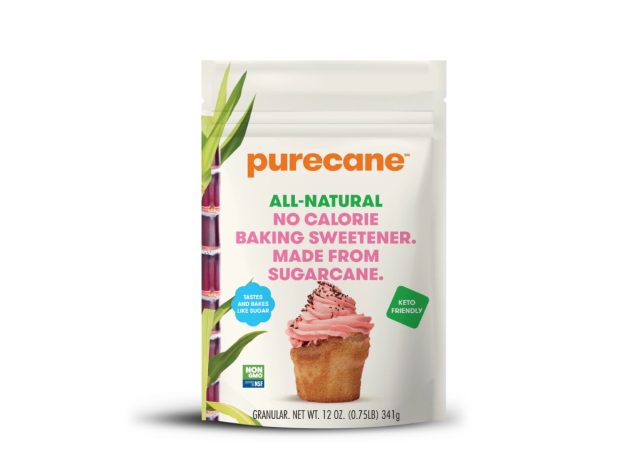I've Never Liked Zero-Calorie Sweeteners, But This One Blew Me Away

Despite my status as a nutritionist, I'll admit I have a serious sweet tooth—which is probably why I've never been a big fan of sugar alternatives. It's always seemed to me like science hasn't quite figured out how to mimic the taste of sugar without an unpleasant aftertaste or strange texture. Plus, like many people, I've been wary of faux sugars' safety. If I'm going to indulge in something sweet, I figure it's worth going for the real thing.
Recently, though, I had the opportunity to try the zero-calorie, low-glycemic sugar alternative Purecane. My expectations were set pretty low, but the idea of experimenting with a bit of kitchen science appealed to me. Maybe, I thought, I could try it out in some baked goods to see exactly how it affected the finished product. After all, we could all stand to cut back on sugar in our diets (yes, even us nutrition professionals!), and food science experiments are nearly always fun.
I was surprised by the taste and texture.
With this in mind, I duly whipped up a batch of lemon muffins, replacing their sugar content entirely with Purecane. (The brand states that it can be used as a one-to-one substitute for sugar.) When the baked goods emerged from the oven, their appearance and texture were no different from what I'd expect from a recipe with real sugar. They rose nicely with perky yellow tops and featured a nice moistness and tender crumb.
But for the true test: what about their taste? Biting into the muffins, I was immediately surprised. They were pleasantly sweet with just the faintest hint of aftertaste. I can't even say for certain I would have noticed it had I not known they contained a sugar alternative. For me, this was earth-shattering—and motivated me to experiment some more.
My next step was to determine whether there was a level of substitution that made Purecane totally unnoticeable. This time, I used a half-sugar, half-Purecane blend in another batch of lemon muffins. Success! I genuinely could tell no difference between this recipe and one with all sugar (and neither could my husband or my kids). That's saying a lot given that I bake muffins around once a week.
Since then, I've used the half-and-half trick to cut back on sugar in cakes, cookies, and—most recently—buttercream frosting, using Purecane's zero-calorie powdered sugar. In a vanilla buttercream, I found using half Purecane actually gave the frosting even greater creaminess without impacting flavor. (In chocolate buttercream, however, I noticed a slight aftertaste.)
All in all, I'm sold—especially since Purecane's sweetening ingredient, Reb M, is safe and all-natural.
What is Purecane?

Ok, you might think, maybe Purecane may taste like sugar, but zero-calorie sugar substitutes don't have the sweetest reputation. (Check out our explainer on alternative sweeteners' safety.) So what exactly is Purecane, and is it full of funky stuff you shouldn't put in your body?
Purecane is made with a substance called sugarcane Reb M, plus some erythritol for added texture and volume. Reb M sounds like a secret agent name, but in reality, it's short for rebaudioside M, a sweetness molecule found in both stevia plants and sugarcane.
"Reb M is only present in small quantities in the stevia plant, so it is mass-produced from sugarcane," explains Kris Sollid, RD, Senior Director of Nutrition Communications at the International Food Information Council (IFIC). (Sollid has no affiliation with Purecane.) "To produce sugarcane Reb M, sugarcane is fermented with genetically modified yeast that converts the natural sugar in sugarcane to Reb M and other steviol glycosides."
The upside: not only does Reb M come from actual sugarcane, but it also retains a super-sweet flavor.
"There are numerous types of rebaudiosides, but Reb M is known for being less bitter and better tasting," says Sollid. No wonder I couldn't taste it in my baked goods!
As for Purecane's other primary ingredient, erythritol, it's a sugar alcohol with zero calories that doesn't raise blood sugar. Erythritol isn't nearly as sweet as Reb M, but it does provide about 70% of the sweetness of real sugar.
Is Purecane safe?
The next question, of course, is whether Purecane's ingredients come with any drawbacks for health. Although the science on nonnutritive sweeteners continues to evolve, according to Sollid, so far, there's no reason to be concerned about Reb M's health effects.
"Although Reb M and other stevia sweeteners have not been used in the food supply as long as some other food ingredients, their safety has been studied and confirmed," he says. "In 2008, the FDA made its first GRAS (Generally Recognized as Safe) determination on a stevia sweetener, rebaudioside A or Reb A. Reb M was added to the FDA's GRAS list in 2014."
Erythritol, too, has been FDA-approved since 2001 and has consistently been demonstrated as safe in human and animal studies. Pretty sweet!
Who is Purecane a good choice for?
If you're on a keto diet, eating low-carb, or living with diabetes, Purecane could offer an excellent antidote for sweet cravings. Though Purecane technically contains four grams of carbs per one-teaspoon serving, according to the company's website, these carbohydrates pass through the body undigested, leaving no impact on blood sugar. That's how this alt-sweetener gets its low-glycemic index rating and zero-calorie status.
As for me, a health-conscious home baker looking for a way to cut back on sugar, it's a great solution, too! I'm dreaming up all the other sweet treats I can make a little healthier with my newfound sugar stand-in.









